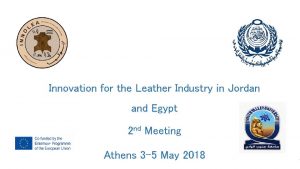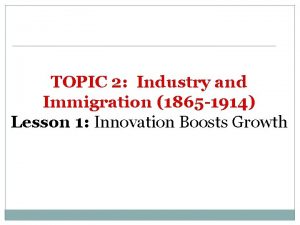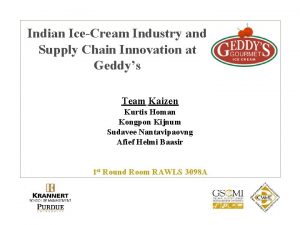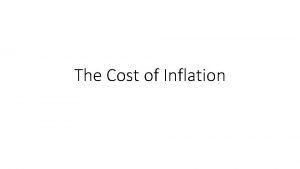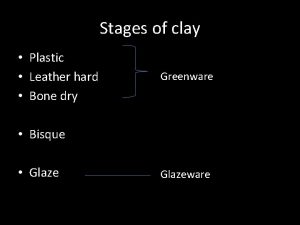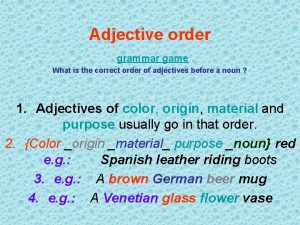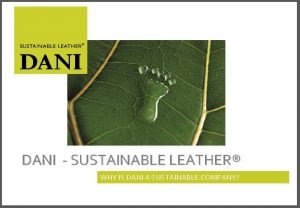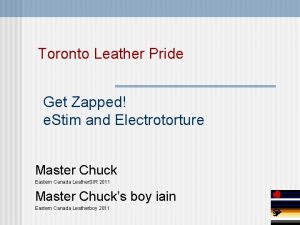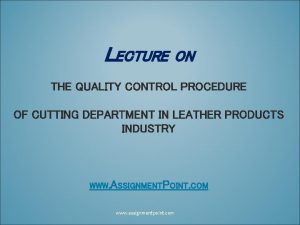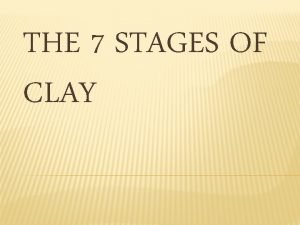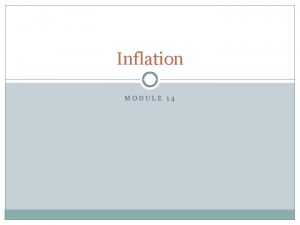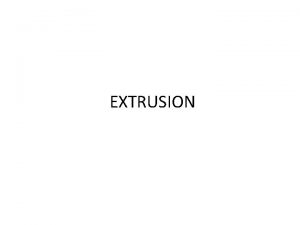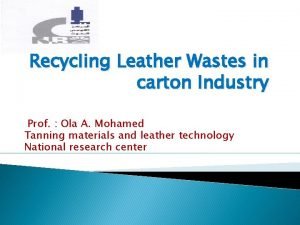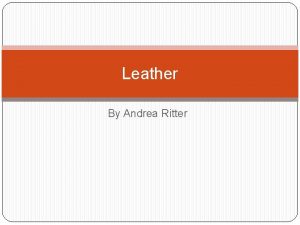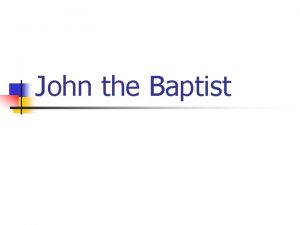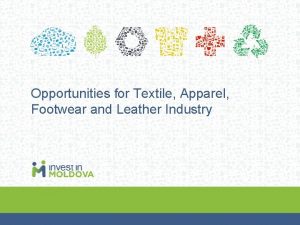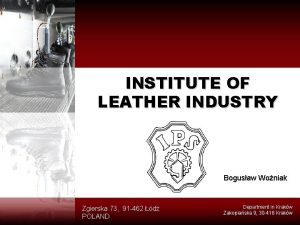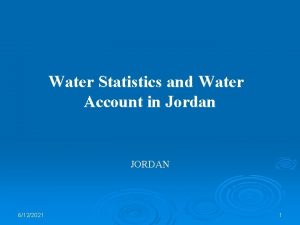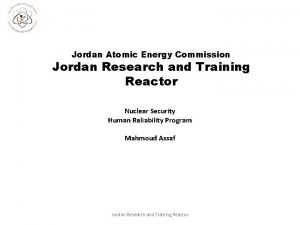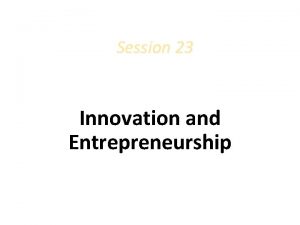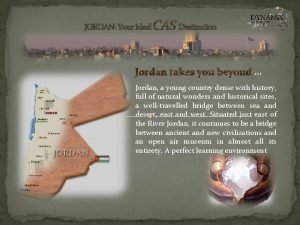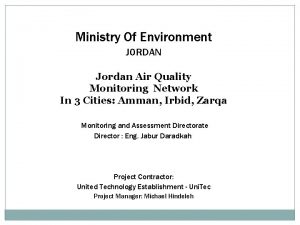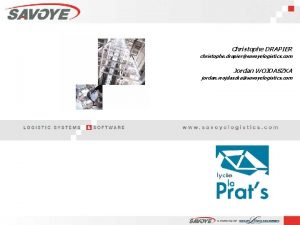Innovation for the Leather Industry in Jordan and
























- Slides: 24

Innovation for the Leather Industry in Jordan and Egypt 2 nd Meeting Athens 3 -5 May 2018

Thank you AASTMT and SVU Team • • • Dr. Gehan Saleh Dr. Sandra Haddad Dr. Sahar El Barky Dr. Ahmed Abdel Kader Dr. Gamal Haikel • Dr. Mahmoud Sadek • Dr. Emad Asd 2

Findings 3

EGYPT • Classified as one of the emerging markets. With a GDP of 330 Million Dollar in nominal prices. • 55. 7% of GDP is generated by services sector, industrial sector with a 33. 1% of the GDP and 11. 9% for Agricultural sector. • However, the agricultural sector provides 29% of the jobs, exceeding industrial sector that employs only 23. 5% of the labor force (CBE, 2017). • In 2016, Leather industry contribution to the manufacturing sector added value is limited to the level of 0. 4% of $55. 5 billion total added value for the Egyptian manufacturing sector. This shows that the opportunity for the development of the leather sector (Unido, 2017). 4

Ancient history of Egyptian leather • Egyptian history has a traditional wealth in manufacture and use of leather and leather products as seen in the tombs of pharaonic civilization. A Statue displayed in the Egyptian Museum in Cairo of King Pepi II ( 2235 -2141 B. C) shows the king holding his leather back bag. It is the earliest sign in the history of humanity of leather products. • Another evidence of the leather industry in Egypt goes back to 2300 B. C. . A painting on the walls of Beni Hassan tomb shows the phases of manufacturing of a leather sandal in ancient Egypt. The paint shows 3 workers, the first a shoe maker cuts the sandal standardized components from the leather material into soles and strings; the second shoemaker is pressing the leather flat; the third threads the strings with his teeth and the fourth bores through the wings of the sandal. Each shoemaker has his tools placed at the working position. The painting features the earliest example of division of labor in footwear manufacturing in the history by the mankind. 5

Structure of Leather Sector Egypt Tanning Companies Manufacturing Companies 6

Institutional Support for Leather Industry in Egypt Chamber of Tanning Industries & Chamber of Leather Industries Export Councils Egyptian Exporters Association (Expolink) Footwear Training Centre – Amereya Footwear and Leather Industry Service Centre (FLISC) Leather Technology Center Egyptian Organization for Standardization and Quality Control Chemical Department 7

Government new vision In response to industrial and environmental needs, the Egyptian government has made the decision to transfer the tanning industry, presently situated in Old Cairo, in the heart of the capital, to the industrial area near of Badr City (Al-Robikki area a new organized leather cluster), which is situated approximately 45 kilometres from the capital with an area of about 6616 square KM. This decision by the government is of particular historical importance: on the one hand it is a choice imposed by the limits of environmental acceptability of urban industrial development, and on the other it expresses a desire to take the opportunity to support and strengthen the Egyptian tanning industry by helping it to become part of an industrial economy. 8

The number of leather skins according to the quality grades (by piece) type grade 1 cows 870311 buffalo 286911 sheep 415583 goats 19757 veal 4249 camels 75050 total 1671861 grade 2 grade 3 damaged whole sale 35291 2994 17 9086166 12937 594 36 300487 46443 14591 23 476640 90 ــ 58 19905 663 6 ــ 4918 11741 2647 15 89453 107165 20835 149 1800010 9

Local production quantity and value in the leather industry in the private sector in 2014/2015 2014 Statement tanned cows leather tanned sheep leather tanned goat leather other animals tanned leather bags genuine leather handmade genuine leather bags genuine leather wallets leather or plastic or other textile boxes Conveyor belts and transmission conveyors of natural or reconstructed leather Belts of natural or artificial leather Leather Products unit volume Values 2015 Quantity Values feet Thousand pieces 372376 288046 3381249 2247751 67 38 163 9922 7201 23200 29432 2016 11923 3907 276334 12960 72766 2811072 0 19 22 7891 276 921 45208 0 4966 935 Thousand pieces 46 415 0 0 tons 47 734 48 769 Thousand pieces 8 354 10 989 Thousand pieces 13 5358 4686 10 23333

Local production quantity and value in the leather industry in the private sector in 2014/2015 leather men shoes leather women shoes leather kids shoes Professional protective shoes other sports shoes leather flip-flops other shoes parts leather sandals 2014 2015 quantity (in pairs) value in EGP 641458 313218 14900 38260 493379 161184 0 0 50241 20667 561 5926 28122 4822 1782 0 415917 250049 172023 33883 423964 22439 0 4000 34334 11666 4386 3389 24028 5824 981 480 11

Findings 12

Focus Group Methodology • 3 FG were in Cairo at the Egyptian German Chamber of Commerce on the 28 th of March 2018 • 1 FG was conducted in Alexandria at AASTMT premises on the 24 th of April 2018. • The number of participants was between 4 -5 participants in each focus group. • The total number of participants was 19 13

Focus Group Methodology • Each focus group discussion took about 120 minutes. • The focus groups also included Participants from: • Egyptian Industrial Chamber as a policymaker • leather manufacturing • Tanneries • Universities • The proposed list from the work package leader JUST included 10 generic questions which was then expanded to 25 questions by AASTMT team to be tailored to Egyptian market. 14

Focus Group Methodology • In the first set of questions, we asked about the status and the future of the leather industry in the country. • In the second set of questions, we asked about the needed steps and regulations from the government to help the leather industry in the country. • In the third set of questions, we asked about the collaboration with the universities • In the forth set of questions, we asked about the Strengths, weakness, opportunities and threats. 15

Section 1: First Theme: The status and the future of the leather industry in the country : Main Findings Materials Egyptian hides and skins are of high quality and rated as one of the best sources of leather in the world. Most of chemicals used for leather manufacturing are imported and not manufactured locally. Majority of produced leather products do not comply with the international norms and standards. Machines No technological advancements in both tanning and leather finishing processes except for a minority of giant tanneries and producers mainly in the new Robbiki leather industrial area. 16

Section 1: First Theme: The status and the future of the leather industry in the country : Main Findings Manpower There is a big shortage in labor force, due to low wages and inappropriate perception of the field. Labor misbehavior affects the quality of skins, leather and consequently the quality of leather products. Small factories that represent the biggest number of businesses in the field have a small number of employees. Current labor force in the industry of leather are old fashioned, not seeking development. Knowledge is transferred from older experienced labors, disregarding training processes and advancements taking place in the manufacturing processes. Lack of discipline in timing, production scheduling, product quality, etc. ). The existence of a very limited number of specialized technical faculties that graduate professional trained candidates for the leather industry. The Egyptian market seeks innovative product designers. 17

Section 1: First Theme: The status and the future of the leather industry in the country : Main Findings Methods/ Approaches Ranching and animal-life actions affect the quality of the skins. Low quality skins may result from poor and inappropriate skinning practices that take place in the slaughterhouses. The absence of mass production technologies in leather-product manufacturing affects quality, cost and profitability. There is a deficiency in the specialized technical support given to the factories, particularly in the field of raw materials and chemicals used in tanning and finishing. Unprofessional inspection process and unskilled inspectors are weak points in the import and export stages. There is no specialization and no job description for those who are working at any stage of leather 18

Second Theme: The needed steps and regulations from the government to help the leather industry in the country: Main Findings • The government is trying to regulate and organize the industry by establishing the Robikki leather industrial area in Cairo. • All participants agreed on the following kinds of support from government: • put greater emphasis on the inspection of imported and exported leather and leather products. • set higher penalties for those who violate laws and export raw leather. • More accredited labs should be available to test the quality of the raw leather and apply the international certifications to them. • Provide effective educational and training courses for labors, technicians, engineers and designers. • Provide support for local chemical factories to manufacture raw materials needed for the leather production, instead of importing them. • Provide support for local factories to manufacture and develop accessories and auxiliaries needed for the leather fabrication. • Promote effectively the leather products in international exhibitions. 19

Third Theme: The Collaboration with the Universities • Graduates from the academic institutes need to be trained on leather products fabrication and processing particularly in the stage of finished goods design, marketing and sales. • There is a need for more centers to: • Provide quality certificates for the exported products. • To work as a verification body for the importing companies. • The tannery owners and producers asked for labs that provide two categories of testing (physical and chemical): • Percentage of chrome • Softness vs hardness of leather • Thickness of leather • • Evenness and consistency of color Fixedness of colour Flexibility test Durability test • Porosity and permeability of water • Percentage of PH • Moisture percentage 20

Third Theme: The Collaboration with the Universities • The tannery owners highlighted a need for more trainings in the areas of deficiencies especially tanning. • As for finished leather products the need emerges for trainings in leather production including: • Operations management • Advanced patron and design training (manual and computerized) • Quality control • Production stages of all leather products (garments, bags, shoes and others) • Providing modern and low cost treatment unit for the effluent waste of the tannery plants. 21

SWOT Analysis Strengths • Availability of raw leather with high quality Long history and expertise (well-known industry INTERNAL ENVIRONMENT based for many years) A huge number of factories, 17, 000 factories and 312 tanneries for leather production (mainly small ones) Availability of Trade agreements (COMESA, etc. ) Geographical position Huge domestic market Availability of universities that can offer training courses Availability of talented workers The establishment of the new leather industrial area in Cairo. Weaknesses • Uninterested labor in learning new methods and advancements Manufacturers have insufficient funds for improving themselves Small entities represent the largest proportion of leather manufacturing low emphasis is placed on logistical activities Most of chemicals used for leather manufacturing are imported and not manufactured locally. Produced leather products do not comply with the international norms and standards. Minor technological advancements in both the tanning and leather finishing processes. Labor misbehavior affects the quality of skins, leather and consequently the quality of leather products. Labors in the industry of leather are old fashioned, not seeking improvement. The absence of mass production technologies in leather-product manufacturing affects quality, cost and profitability. There is a deficiency in the specialized technical support given to the factories, particularly in the field of raw materials and chemicals used in tanning and finishing. Lack in quality procedure in all supply chain activities of the sector. 22

SWOT Analysis Opportunities Threats • EXTERNAL ENVIRONMENT • High demand for substances needed for manufacturing leather Using mass production and achieving economies of scale High demand for leather products in the Egyptian market High demand for leather in other countries Geographical position is accessible for exporting More involvement in international Exhibitions. Inflation on the products Anticipated decrease in the tariff rate on imported goods Indian and Chinese finished goods of relatively high quality Competitive pricing of the international suppliers of leather finished products There is a big threat for the industry as the old the experienced workers are aging without a mechanism for transferring experience between generations. 23

 Jordan leuther
Jordan leuther Mysite socccd
Mysite socccd Disruptive and radical innovation
Disruptive and radical innovation Topic 2 industry and immigration
Topic 2 industry and immigration Ice cream value chain
Ice cream value chain Physics 1
Physics 1 Problems of inflation
Problems of inflation Shoe leather cost
Shoe leather cost Leather hard clay
Leather hard clay A slingshot consists of a light leather cup
A slingshot consists of a light leather cup Signing naturally my favorite leather jacket
Signing naturally my favorite leather jacket Adjective order rule
Adjective order rule Motion simple definition
Motion simple definition Shoe leather survey fluoride
Shoe leather survey fluoride Dani sustainable leather
Dani sustainable leather Toronto leather pride
Toronto leather pride Fable 2 intro
Fable 2 intro Cutting quality control
Cutting quality control The commonly used angle between leather or asbestos
The commonly used angle between leather or asbestos 7 stages of clay
7 stages of clay A slingshot consists of a light leather cup
A slingshot consists of a light leather cup Shoe leather costs definition
Shoe leather costs definition Shark skin effect in extrusion
Shark skin effect in extrusion Leather waste recycling
Leather waste recycling Iso 22301 utbildning
Iso 22301 utbildning
